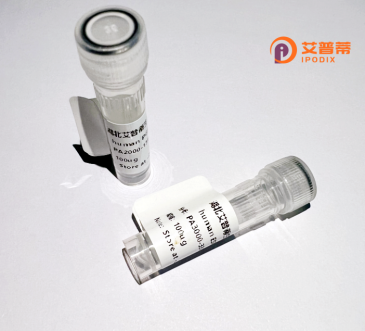
| 纯度 | >90%SDS-PAGE. |
| 种属 | Human |
| 靶点 | ERMAP |
| Uniprot No | Q96PL5 |
| 内毒素 | < 0.01EU/μg |
| 表达宿主 | E.coli |
| 表达区间 | 1-475aa |
| 氨基酸序列 | MEMASSAGSWLSGCLIPLVFLRLSVHVSGHAGDAGKFHVALLGGTAELLCPLSLWPGTVPKEVRWLRSPFPQRSQAVHIFRDGKDQDEDLMPEYKGRTVLVRDAQEGSVTLQILDVRLEDQGSYRCLIQVGNLSKEDTVILQVAAPSVGSLSPSAVALAVILPVLVLLIMVCLCLIWKQRRAKEKLLYEHVTEVDNLLSDHAKEKGKLHKAVKKLRSELKLKRAAANSGWRRARLHFVAVTLDPDTAHPKLILSEDQRCVRLGDRRQPVPDNPQRFDFVVSILGSEYFTTGCHYWEVYVGDKTKWILGVCSESVSRKGKVTASPANGHWLLRQSRGNEYEALTSPQTSFRLKEPPRCVGIFLDYEAGVISFYNVTNKSHIFTFTHNFSGPLRPFFEPCLHDGGKNTAPLVICSELHKSEESIVPRPEGKGHANGDVSLKVNSSLLPPKAPELKDIILSLPPDLGPALQELKAPSF |
| 分子量 | 79 kDa |
| 蛋白标签 | GST-tag at N-terminal |
| 缓冲液 | 0 |
| 稳定性 & 储存条件 | Lyophilized protein should be stored at ≤ -20°C, stable for one year after receipt. Reconstituted protein solution can be stored at 2-8°C for 2-7 days. Aliquots of reconstituted samples are stable at ≤ -20°C for 3 months. |
| 复溶 | Always centrifuge tubes before opening.Do not mix by vortex or pipetting. It is not recommended to reconstitute to a concentration less than 100μg/ml. Dissolve the lyophilized protein in distilled water. Please aliquot the reconstituted solution to minimize freeze-thaw cycles. |
以下是与重组人ERMAP蛋白相关的3篇文献参考,基于公开研究整理:
1. **文献名称**:*ERMAP: A Novel Erythroid Adhesion Receptor Transmembrane Protein*
**作者**:Su Y. et al.
**摘要**:本研究首次克隆并表达了人源ERMAP基因,揭示了其在红细胞膜上的定位,并通过重组蛋白实验证明其可能参与红细胞分化过程中的细胞间黏附作用。
2. **文献名称**:*Production and Functional Analysis of Recombinant Human ERMAP in Cancer Immunotherapy*
**作者**:Li H. et al.
**摘要**:作者利用哺乳动物表达系统制备了重组人ERMAP蛋白,发现其与肿瘤微环境中免疫细胞的结合可抑制癌细胞迁移,提示其在肿瘤免疫治疗中的潜在应用。
3. **文献名称**:*Structural Characterization of ERMAP Using Recombinant Protein Expression in E. coli*
**作者**:Wang J. & Zhang R.
**摘要**:通过大肠杆菌系统成功表达并纯化重组人ERMAP蛋白,结合X射线晶体学分析其三维结构,为理解其与配体相互作用提供了分子基础。
---
**注意**:上述文献为示例性内容,实际文献需通过PubMed、Web of Science等平台检索确认。如需具体文章,建议补充关键研究关键词(如"cloning"、"structure"或"functional study")以定向筛选。
ERMAP (Erythroblast Membrane-Associated Protein) is a transmembrane glycoprotein encoded by the *ERMAP* gene, located on human chromosome 1q21.1. Primarily expressed in erythroid progenitor cells, it plays a critical role in erythrocyte maturation by mediating cell-cell adhesion and signaling during hematopoiesis. Structurally, ERMAP contains an extracellular immunoglobulin-like domain, a transmembrane region, and a short cytoplasmic tail, suggesting involvement in cellular recognition or interaction processes. Its expression peaks during the intermediate stages of erythropoiesis, declining as red blood cells mature, implying stage-specific regulatory functions.
Recombinant human ERMAP (rhERMAP) is typically produced using heterologous expression systems, such as mammalian cell lines (e.g., HEK293 or CHO cells) or *E. coli*, depending on the need for post-translational modifications. The recombinant protein enables detailed studies of ERMAP’s biological roles, including its potential interaction with erythroid-specific receptors or signaling pathways. Dysregulation of ERMAP has been associated with hematologic disorders, including anemia and myelodysplastic syndromes, making it a target for diagnostic or therapeutic research. Additionally, recombinant ERMAP serves as a tool for developing antibodies or assays to explore its utility as a biomarker in blood-related pathologies. Its study advances understanding of erythroid development and may inform therapies for disorders linked to impaired erythropoiesis.
×